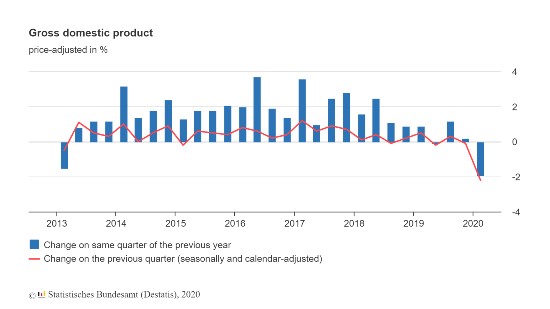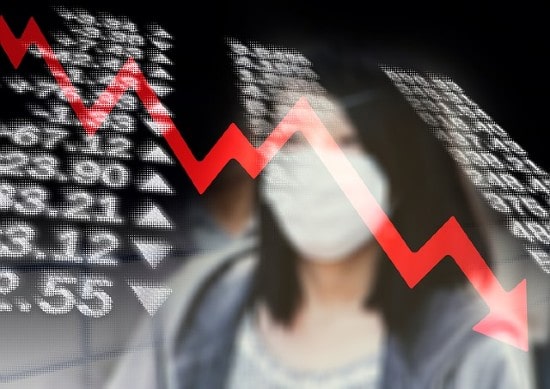The corona pandemic has hit the German economy hard. According to the Federal Statistical Office (Destatis) report, the gross domestic product (GDP) in Germany decreased by 2.2% in the first quarter of 2020 compared to the previous quarter.
That was the largest decrease since the global financial and economic crisis of 2008/2009 and the second largest decrease since German unification. A larger quarter-on-quarter decline was recorded only for the 1st quarter of 2009 (-4.7%). Although the spread of the novel coronavirus did not have a major effect on the economic performance in January and February, the impact of the pandemic was quite serious even for the 1st quarter of 2020.
Due to the coronavirus pandemic and the restrictions related with it, households consumed much less in the 1st quarter of 2020 than in the 4th quarter of 2019. Household final consumption expenditure decreased by 3.2% on the previous quarter after price, seasonal and calendar adjustment. Gross fixed capital formation in machinery and equipment was down by as much as 6.9%. Final consumption expenditure of general government and gross fixed capital formation in construction had a stabilising effect. They prevented an even larger GDP decrease. While general government final consumption expenditure rose by 0.2%, gross fixed capital formation in construction increased considerably by 4.1% from the 4th quarter of 2019.
Foreign trade also declined in the 1st quarter of 2020. According to provisional calculations, exports were down 3.1% from the 4th quarter of 2019 after price, seasonal and calendar adjustment. While exports of goods decreased by 4.0%, exports of services increased slightly by 0.7 %. Imports of goods and services were down 1.6%.
The German economy slumped also in a year-on-year comparison. GDP in the 1st quarter of 2020 was down a price-adjusted 1.9% and a calendar-adjusted 2.3% from a year earlier. Only during the years of the financial and economic crisis of 2008/2009 had there been stronger year-on-year declines, the largest one (-7.9%) was observed in the 2nd quarter of 2009 (a calendar-adjusted -6.9% in the 1st quarter of 2009).

The economic performance in the 1st quarter of 2020 was achieved by roughly 45 million persons in employment whose place of employment was in Germany. That was an increase of 147,000 people, or 0.3%, on a year earlier. Such a small year-on-year increase had last been observed in the 2nd quarter of 2010. The corona pandemic thus had only a moderate impact on the number of persons in employment in the 1st quarter of 2020, one of the reasons being that short-time workers are counted as persons in employment.
READ ALSO : Eurozone GDP sees sharpest decline since 2009
However, the fact that more people worked short-time in the second half of March had a substantial impact on the average number of hours worked per person in employment. It decreased markedly by 1.7% in the 1st quarter of 2020 from the same quarter of 2019, according to first provisional results of the Institute for Employment Research of the Federal Employment Agency. The labour volume of the overall economy, which is the total number of hours worked by all persons in employment, went down by 1.3% over the same period.
Overall labour productivity (price-adjusted GDP per hour worked by persons in employment) fell 0.6% compared with the same quarter of 2019, according to provisional calculations. Labour productivity per person in employment was 2.2% lower than in the 1st quarter of 2019.
There was much less domestic and foreign demand also in comparison with a year earlier. Gross fixed capital formation in machinery and equipment fell sharply (-9.2%). Household final consumption expenditure dropped a price-adjusted 2.2% on a year earlier. In contrast, an additional 2.3% in government final consumption expenditure supported the economy. Gross fixed capital formation in construction was up 4.8% from the 1st quarter of 2019. There was a particularly large increase of general government gross fixed capital formation in construction, above all in public civil engineering.
Foreign demand did not make any positive contributions. According to provisional calculations, exports of goods and services fell by 3.2% (price-adjusted) in the 1st quarter of 2020 year on year. Imports did not drop as strongly (-1.7%) over that period.
On the production side of GDP , diverging trends were observed in the various economic sectors in the 1st quarter of 2020 compared with the 1st quarter of 2019. Last year’s downward trend continued in manufacturing. However, the 6.4% drop of the gross value added is far from the double-digit decreases recorded during the financial and economic crisis of 2008/2009. The same applies to the business services sector, whose economic performance fell by 1.2%. Trade, transport, accommodation and food services also experienced a considerable decline (-3.0%). Construction, in contrast, recorded a marked year-on-year increase by 4.0%. There were increases also in information and communication (+1.5%) and in financial and insurance activities (+1.4%). Total price-adjusted gross value added decreased by 1.8%
At current prices, both the GDP and the gross national income were up 0.5% in the 1st quarter of 2020 compared with a year earlier. Net national income at factor costs was at around the level of the previous year (+0.1%) due to diverging developments of the two components. While the compensation of employees (gross wages and salaries plus employers’ social contributions) increased by 2.4%, property and entrepreneurial income was down 5.1% according to first provisional calculations. Gross wages and salaries of employees rose by 2.5% from the 1st quarter of 2019, net wages and salaries by 2.6%. On average, wages and salaries per employee did not rise that much (+1.8% in gross terms, +2.0% in net terms) because the number of employees continued to grow (+0.6%) compared with the same quarter a year earlier. The disposable income of households was up by 2.1%, whereas the final consumption expenditure of households at current prices was down by 0.6%. According to provisional calculations, the resulting quarterly savings ratio was rather high (16.7%).





















